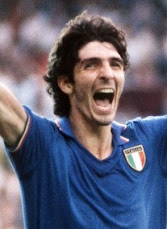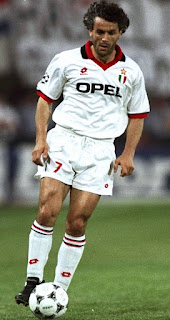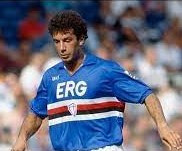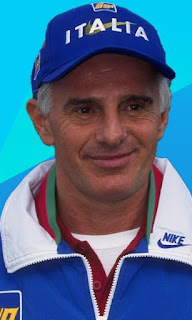Argentina star hailed as a ‘messiah’ by Neapolitans
SSC Napoli, a club who had never won Italy’s Serie A since their formation in 1926 and lived in the shadow of the powerful clubs in the north of the country, stunned the football world on this day in 1984 by completing the world record signing of Argentina star Diego Maradona..jpg)
Diego Maradona helped SSC Napoli to
reach the top of the Italian football world
Maradona, who would captain his country as they won the World Cup in Mexico two years later, agreed to move to Napoli from Spanish giants Barcelona, who he had joined from Argentina club Boca Juniors in 1982.
Although the Catalan team had been keen to offload him after two years in which Maradona had never been far from controversy, his arrival in arguably the poorest major city in Italy, whose team had finished 10th and 12th in the previous two Serie A seasons, was still a sensation.
Maradona’s unveiling at the Stadio San Paolo on 5 July, 1984 attracted a crowd of 75,000 to the stadium. Napoli supporters were fanatical about their team despite their lack of success and were thrilled to have a distraction at a time when problems with housing, schools, buses, employment and sanitation were making daily life in Naples very difficult.
The world record fee of £6.9 million was funded in part by a loan arranged by a local politician.
Napoli fans immediately identified with Maradona, who hailed from a working class background in Buenos Aires and made his name playing with a club, Boca Juniors, which represented a part of the city that was home to many ex-patriate Italians and their descendants.
 |
| Maradona was unveiled before 75,000 fans at the Stadio San Paolo |
Within three seasons, with Maradona captain, Napoli had won the Serie A championship. At a time when Italy’s north-south divide was being sharply felt in the south with a wide economic disparity between the two halves of the country, the reaction in the city was tumultuous.
Neapolitans spilled out onto the streets to hold impromptu parties and motor cavalcades turning Naples into a carnival city for a week. Napoli fans painted coffins in the colours of northern giants Juventus and Milan and burned them in mock funerals.
Ancient, crumbling buildings around the city were decorated with huge murals of Maradona, whose face was in every shop window. Suddenly, Diego became the most popular name for newborn baby boys.
The 1986-87 title season was only the start. Napoli were runners-up in Serie A for the next two seasons and won the title again in 1989-90, also winning the Coppa Italia in 1987, the UEFA Cup in 1989 and the Italian Supercup in 1990.
Although he was primarily an attacking midfielder rather than an out-and-out striker, Maradona was the top scorer in Serie A in 1987–88 with 15 goals, amassing 115 goals in his seven-year stay at the club, which made him Napoli’s all-time leading goalscorer until the record was surpassed by Marek Hamšík in 2017.
Maradona’s relationship with the fans soured a little after his Argentina side defeated Italy in the semi-final of the World Cup in Naples in 1990, after which it broke down completely when his cocaine use led to him repeatedly missing training sessions and some matches, leading ultimately to a 15-month ban and a departure from the club somewhat in disgrace.
Yet to many in Naples he remained a hero and shortly after his death in September 2020, Napoli’s Stadio San Paolo home ground was renamed the Stadio Diego Armando Maradona.
Travel tip:.jpg)
The Palazzo Reale is a legacy of the wealth of
Naples in the 17th and 18th centuries
In recent years, Naples has become the poorest of Italy’s major cities, but in the 17th and 18th centuries it was one of Europe's great cities and many of the city’s finest buildings are a legacy of that period. In the area around Piazza del Plebiscito, for example, you can see the impressive Palazzo Reale, which was one of the residences of the Kings of Naples at the time the city was capital of the Kingdom of the Two Sicilies. The palace is home to a 30-room museum and the largest library in southern Italy, both now open to the public. Close to the royal palace is one of the oldest opera houses in the world, built for a Bourbon King of Naples. Teatro di San Carlo was officially opened on 4 November 1737, some years before La Scala in Milan and La Fenice in Venice. Part of the Bourbon legacy to Naples is the vast Reggia di Caserta, the royal palace commissioned in 1752 by Charles VII of Naples and built by the Italian architect Luigi Vanvitelli along the lines of the French royal palace at Versailles.
Travel tip:
The Stadio San Paolo - now the Stadio Diego Armando
Maradona - is the third largest football ground in Italy
The Stadio San Paolo - now renamed the Stadio Diego Armando Maradona - is Italy’s third largest football ground with a capacity of just over 60,000. Built in the Fuorigrotta neighbourhood on the north side of the city, it was completed in 1959, more than 10 years after work began and has since been renovated twice, including for the 1990 World Cup. The home of SSC Napoli, it was Maradona’s home stadium between 1984 and 1991. The suburb of Fuorigrotta, the most densely populated area of the city, lies beyond the Posillipo hill and has been joined to the main body of Naples by two traffic tunnels that pass through the hill since the early 20th century. The suburb is also the home of the vast Mostra d’Oltremare, one of the largest exhibition complexes in Italy, built in 1937 to host the Triennale d'Oltremare, the aim of which was to celebrate the colonial expansion envisaged by the Fascist dictator Mussolini.
Also on this day:
1466: The birth of military leader Giovanni Sforza
1966: The birth of footballer Gianfranco Zola
1974: The birth of motorcycling champion Roberto Locatelli
1982: The birth of footballer Alberto Gilardino
1982: Paolo Rossi’s hat-trick defeats Brazil at the 1982 World Cup
































